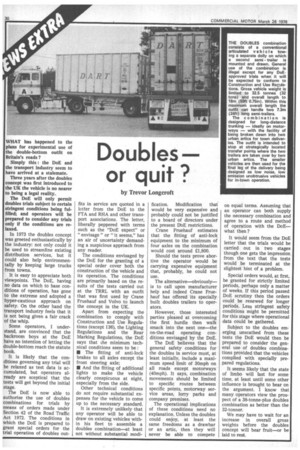Doubles or quit ?
Page 32

If you've noticed an error in this article please click here to report it so we can fix it.
by Trevor Longcroft
WHAT has happened to the plans for experimental use of the double-bottom outfit on Britain's roads ?
Simply this : the DoE and the transport industry seem to have arrived at a stalemate.
Three years after the doubles concept was first introduced to the UK the vehicle is no nearer to being a legal reality.
The DoE will only permit doubles trials subject to certain stringent conditions being fulfilled; and operators will be prepared to consider any trials only if the conditions are relaxed.
In 1973 the doubles concept was greeted enthusiastically by the industry: not only could it be used to streamline existing distribution services, but it could also help environmentally by keeping large trucks from towns.
It is easy to appreciate both viewpoints. The DoE, having no data on which to base conditions of operation, has gone to the extreme and adopted a hyper-cautious approach on safety. On the other hand the transport industry feels that it is not being given a fair crack of the whip.
Some operators, I understand, are convinced that the backroom boys at the DoE have no intention of letting the double-bottom reach the statute book.
It is likely that the conditions governing any trial will be relaxed as test data is accumulated, but operators already are sceptical that the tests will get beyond the initial stage.
The DoE is now able to authorise the use of doubles combinations for trials by means of orders made under Section 42 of the Road Traffic Act 1972. The conditions in which the DoE is prepared to grant special orders for the trial operation of doubles out fits in service are quoted in a letter from the DoE to the FTA and RHA and other transport associations. The letter, liberally peppered with terms such as the "DoE expect" or "envisage " or "it seems," has an air of uncertainty demanding a suspicious approach from any reader.
The conditions envisaged by the DoE for the granting of a special order cover both the construction of the vehicle and its operation. The conditions are primarily based on the results of the tests carried out at the TRRL with an outfit that was first used by Crane Fruehauf and Volvo to launch the concept in the UK.
Apart from expecting the combination to comply with Construction and Use Regulations (except 136), the Lighting Regulations and the Rear Marking Regulations, the DoE says that die minimum technical conditions seem to be : M The fitting of anti-lock brakes to all axles except the front steering axle; • And the fitting of additional lights to make the vehicle clearly conspicuous at night, especially from the side.
Other technical conditions do not require substantial expenses for the vehicle to come up to the necessary standard.
It is extremely unlikely that any operator will be able to draw on existing vehicles within his fleet to assemble a doubles combination—at least not without substantial modi fication. Modification that would be very expensive and probably could not be justified to a board of directors under the present DoE restrictions.
Crane Fruehauf estimates that the fitting of anti-lock equipment to the minimum of four axles on the combination would cost around £1,800.
Should the tests prove abortive the operator would be carrying expensive equipment that, probably, he could not use.
The alternative—obviouslyis to call upon manufacturer help and indeed Crane Fruehauf has offered its specially built doubles trailers to operators.
However, those interested parties pleased at overcoming the first hurdle then walk smack into the next one—the on-the-road operating conditions envisaged by the DoE.
The DoE believes that the general safety conditions for the doubles in service must, at least initially, include a maximum speed limit of 30mph on all roads except motorways (40mph). It says, combination movements should be limited to specific routes between specific points, motorway service areas, lorry parks and company premises.
The operational implications of these conditions need no explanation. Unless the doubles could enjoy, at least the same freedoms as a drawbar or an artic, then they will never be able to compete on equal terms. Assuming that an operator can both supply the necessary combination and agree to a route and method of operation with the DoE— what then ?
It would seem from the DoE letter that the trials would be carried out in two stages though one gets the impression from the text that the tests would be terminated at the slightest hint of a problem.
Special orders would, at first, be granted for strictly limited periods, perhaps only a matter of weeks. If this period passed DoE scrutiny then the orders could be renewed for longer periods. Less stringent safety conditions might be permitted for this stage where operational data could be gathered.
Subject to the doubles emerging unscathed from these tests the DoE would then be prepared to consider the general use of doubles combinations provided that the vehicles complied with specially prepared regulations.
It seems likely that the state of limbo will last for some time, at least until some other influence is brought to bear on the argument. I know that many operators view the prospect of a 38-tonne-plus doubles combination as better than the 32-tonner.
We may have to wait for an increase in overall gross weights before the doubles concept will bear fruit--or be laid to rest.
















































































































